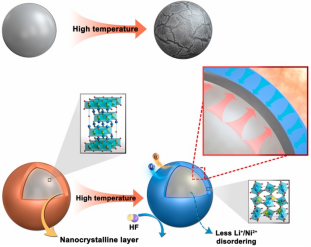Recently, Prof. Ying Bai’s research group from the School of Physics and Electronics has made new progress in the study of the interface regulation of cathode materials for the advanced lithium-ion battery. The related paper entitled Enhancing the structure stability of Ni-rich LiNi0.6Co0.2Mn0.2O2 cathode via encapsulating in negative thermal expansion nanocrystalline shell has been published in the journal of Nano Energy (https://doi.org/10.1016/j.nanoen.2021.105775). Du Kai is the first author, Dr. Huiling Zhao and Prof. Ying Bai are the corresponding authors.

Fig. 1. The illustration for the surface modification of ZVO NTE material inhibiting the structure degradation of bulk NCM622.

Fig. 2. In-situ XRD patterns zoomed in for the (003) plane of the pristine NCM622 (a) and the NCM622@1.0 wt% ZVO (b) samples in the initial cycle with the voltage range of 2.7 ~ 4.3 V and the current density of 0.1 C; (c) Refined lattice constant evolution of c as a function of lithiation-delithiation voltage calculated according to selected curves in (a); (d) the normalized lattice constant of c in a complete cycling.
Ni-rich cathode materials have attracted considerable attention due to the high electrochemical capacities and prominent price advantage, while their extensive applications are still impeded by the poor structure stability induced by the intrinsic Li+/Ni2+ cation mixing and mechanical stress accumulation upon cycling. To address these issues, a typical negative thermal expansion (NTE) material ZrV2O7 (ZVO) is firstly employed as coating layer on LiNi0.6Co0.2Mn0.2O2 (NCM622) particles to promote the electrochemical performances through enhancing the structure stability upon repeated cycling and operating at high temperature. The NCM622@1.0 wt% ZVO sample exhibits excellent cyclability (71.0% capacity retention after 500 cycles under 25 °C and 67.0% capacity retention after 200 cycles under 55 °C) and rate capability (60.7% at 5 C). Further in-situ XRD analysis confirms that the structure stability of NCM622 could be prominently stabilized both under electrochemical and thermal treatments after ZVO decoration. Intensive investigation implies the unique functionalities of ZVO in restraining the stress accumulation and volume expansion, thus contributing to the bulk structure stability and interface compatibility of modified NCM622, besides the traditional effect of surface deposition layers (physical separation between solid electrode/electrolyte and inhibited irreversible surface side reactions).
The research work is supported by the general project of National Natural Science Foundation of China, the sub-project of National Key Research and Development Program, the scientific and technological innovation team of Department of Education of Henan Province, the scientific and technological innovative talents of Department of Education of Henan Province, and the cultivation fund for outstanding youth of Henan University.
Nano Energy is a well-known journal owned by Elsevier, which mainly publishes the latest scientific research progress in the field of materials science and nanotechnology. The latest published impact factor of the journal in 2020 is 16.602.
The link to the paper is https://www.sciencedirect.com/science/article/abs/pii/S2211285521000331.
Contribution: School of Physics and Electronics

 Research /
Research Achievements /
Science & Technology /
School of Physics and Electronics /
Content
Research /
Research Achievements /
Science & Technology /
School of Physics and Electronics /
Content


